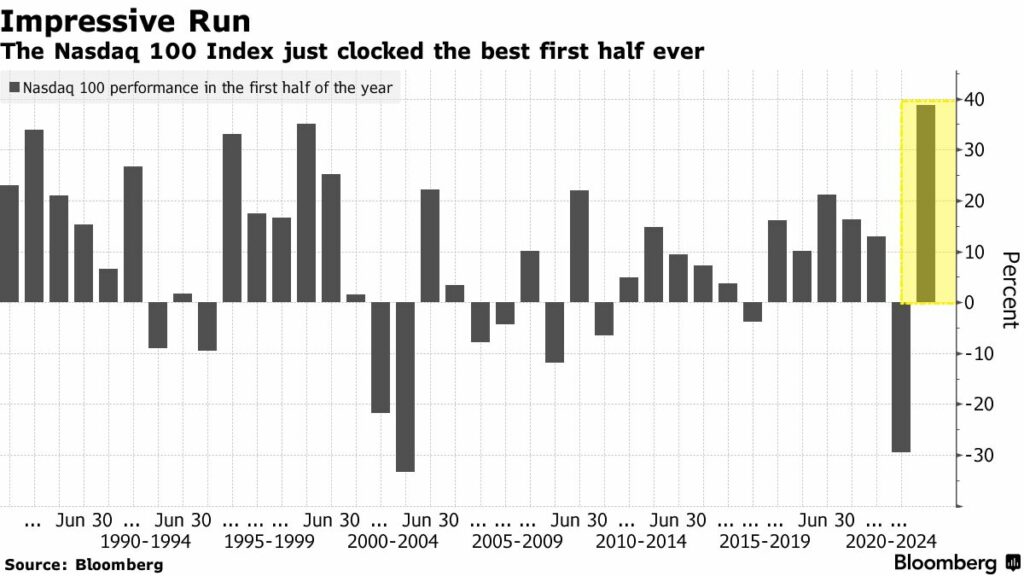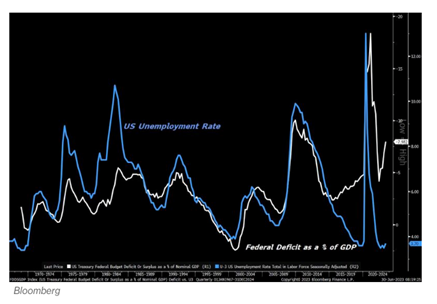Display results

16 August
Stocks Lead the Way
Quick Take: Stocks continue to gain steam as optimism reaches highs relative to bonds.
As the scorching heat produced the hottest month on record, the S&P 500 notched a fifth consecutive positive month, up 3.1%.[1][2] Despite talk of 2023 being the “year of the bond,” bulls have so far created a flood of demand for the stock market.[3] Year-to-date, the S&P has climbed more than 19%, which is less than 5% away from the all-time high reached in January 2022.[4]
Year of the Stocks (so far)
Not many people saw this year’s rally coming. Wall Street strategists have had to revise bearish outlooks in recent weeks and update year-end S&P forecasts higher.[5] More than half of JPMorgan clients surveyed are now convinced that the US economy can continue to expand despite Fed tightening, which could explain the accompanying jump in plans to boost equity exposure. Already, stock exposure, as tracked by the National Association of Active Investment Managers, is at its highest levels since November 2021.[6]
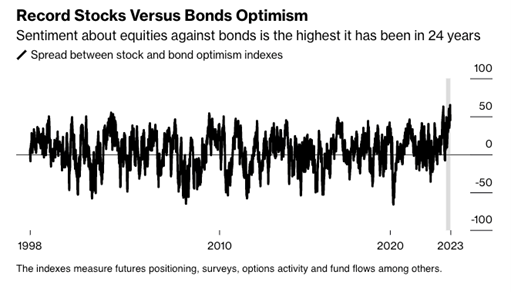
Source: https://www.bloomberg.com/news/articles/2023-07-29/stocks-crush-year-of-bond-in-biggest-market-sentiment-shift-since-99
According to SentimenTrader models, investors are more optimistic about stocks relative to bonds than they have been in 24 years.[7] The fund flows reflect that sentiment – exchange-traded funds have seen a strong preference for equities over fixed income the last three months, which is a notable reversal from the beginning of the year.[8]
The shift has come from signs of slower inflation combined with strong economic data. Inflation continued to cool in June even as consumer spending rose, reflecting sustained economic momentum.[9] With the Fed potentially closer to ending interest rate hikes, the dollar is also falling, which could provide support to corporate profits.[10]
So where does the stock outperformance leave bonds?
Given the strength in stocks, the additional reward for holding stocks over bonds has dropped to its lowest level in 20 years.[11] This equity “risk-premium” can be measured by the difference between the S&P 500 earnings yield and the yield on the 10-year US Treasury inflation-protected bond.
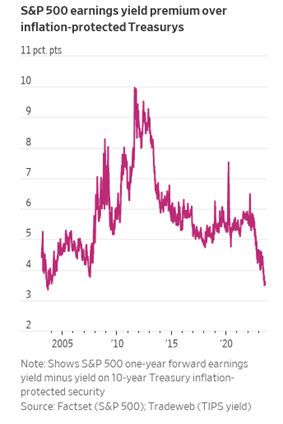
Source: https://www.wsj.com/articles/the-benefit-of-owning-stocks-over-bonds-keeps-shrinking-20528203
Bond bulls would argue that at high interest rates, bond coupon payments provide attractive low-risk income. Further, as the Fed seemingly approaches the end of this interest rate hike cycle, bond yields could head lower (prices higher). As inflation comes down and markets anticipate rate cuts in 2024, bonds could begin to outperform.[12]
Of course, bond markets can be driven by other factors, and we would be remiss if we didn’t touch on recent events in Japan. The Bank of Japan has historically anchored its interest rates to “rock-bottom” levels through a quantitative easing program used to stimulate the economy.[13] As a result, Japanese investors have spent more than $3 trillion investing offshore in search of higher yields.[14]
At the end of July, the Bank of Japan surprised the market by loosening its grip on yields in what could be a significant shift for global financial markets.[15] Even slight shifts in policy away from easy money could potentially bring some offshore money back to Japan and also drive up rates globally.[16]
In Pursuit of a Soft landing
Back in the US, the Fed hiked interest rates by another 25 bps in July, as anticipated.[17] After increasing 11 times from near zero rates in March 2022, the federal funds target rate is now 5.25-5%.[18] The fed funds rate guides borrowing costs that can restrict or expand financial conditions. To combat inflation, the Fed has been aggressively hiking rates to slow demand, which many expected to trigger a recession.[19]
Now a Goldilocks “soft-landing” scenario of falling prices without substantial unemployment has been playing out. The Fed’s preferred measure of inflation, the core personal consumption expenditures index, rose to only 4.1% in June, compared to the estimated 4.2% and marks the lowest annual rate level since September 2021.[20] A resilient job market supported consumer spending, and the US economy grew faster than expected in the second quarter as measured by GDP.[21]
It’s important to note that the Fed would still like inflation to come back down to the 2% target, and timing rate cuts is also critical to a successful soft landing.
Many Fed researchers no longer expect a recession, and Fed chair Jerome Powell expects that the Fed can cool inflation without a large increase in unemployment.[22] Markets are growing increasingly hopeful that the Fed might be able to pull off a soft landing.
Looking Ahead
The Fed still plans to set policy based on incoming data, and Powell noted that “at the margin, stronger growth could lead, over time, to higher inflation, and that would require an appropriate response from monetary policy.”[23]
That opens the door for further interest rate hikes or higher rates for longer, if necessary. The next Fed rate decision will be in September. To complicate matters, measures of financial conditions have actually been easing since last year, coinciding with the equities rally.[24] Recent and upcoming earnings reports may provide more clarity on how companies have been weathering higher rates, though policy effects operate with a lag.
This year’s stock market performance underscores the futility of trying to time the market. Instead, we focus on crafting balanced and diversified portfolios that meet your personal objectives and needs. It’s also worth noting that our portfolios are not likely to match this year’s stock performance exactly — our strategies are typically designed to capture opportunities throughout the market cycle.
Let us know if we can address any questions, discuss recent developments, or talk strategy on a call. We hope you stay hydrated and refreshed for the remaining days of summer!
Your Friends at JSF
The information expressed herein are those of JSF Financial, LLC, it does not necessarily reflect the views of NewEdge Securities, Inc. Neither JSF Financial LLC nor NewEdge Securities, Inc. gives tax or legal advice. All opinions are subject to change without notice. Neither the information provided, nor any opinion expressed constitutes a solicitation or recommendation for the purchase, sale or holding of any security. Investing involves risk, including possible loss of principal. Indexes are unmanaged and cannot be invested in directly.
Historical data shown represents past performance and does not guarantee comparable future results. The information and statistical data contained herein were obtained from sources believed to be reliable but in no way are guaranteed by JSF Financial, LLC or NewEdge Securities, Inc. as to accuracy or completeness. The information provided is not intended to be a complete analysis of every material fact respecting any strategy. The examples presented do not take into consideration commissions, tax implications, or other transactions costs, which may significantly affect the economic consequences of a given strategy. Diversification does not ensure a profit or guarantee against loss. Carefully consider the investment objectives, risks, charges and expenses of the trades referenced in this material before investing.
Asset Allocation and Diversification do not guarantee a profit or protect against a loss.
The Bloomberg Barclays U.S. Aggregate Bond Index measures the investment-grade U.S. dollar-denominated, fixed-rate taxable bond market and includes Treasury securities, government-related and corporate securities, mortgage-backed securities, asset-backed securities and commercial mortgage-backed securities.
The S&P 500 Index is an unmanaged, market value-weighted index of 500 stocks generally representative of the broad stock market.
The Nasdaq Composite is a market-capitalization-weighted index consisting of all Nasdaq Stock Exchange listed stocks that are not derivatives, preferred shares, funds, exchange-traded funds or debenture securities.
Treasury Bond- is a U.S. government debt security with a fixed interest rate and maturity between two and 10 years.
Gross domestic product (GDP) is a monetary measure of the market value of all the final goods and services produced in a specific time period. GDP is the most commonly used measure of economic activity.
By clicking on these links, you will leave our server, as they are located on another server. We have not independently verified the information available through this link. The link is provided to you as a matter of interest. Please click on the links below to leave and proceed to the selected site.
[1] July is already the warmest month on record, scientists calculate | AP News
[2] Stock market today: Live updates (cnbc.com)
[3] https://www.bloomberg.com/news/articles/2023-07-29/stocks-crush-year-of-bond-in-biggest-market-sentiment-shift-since-99
[4] Wall St. Pessimists Are Getting Used to Being Wrong – The New York Times (nytimes.com)
[5] Stocks Crush ‘Year of Bond’ in Biggest Market Sentiment Shift Since ‘99 – Bloomberg
[6] Wall St Week Ahead Relentless U.S. stock rally faces Fed test | Reuters
[7] Stocks Crush ‘Year of Bond’ in Biggest Market Sentiment Shift Since ‘99 – Bloomberg
[8] https://www.bloomberg.com/news/articles/2023-07-29/stocks-crush-year-of-bond-in-biggest-market-sentiment-shift-since-99
[9] Economic Data Bolster Soft Landing Hopes – The New York Times (nytimes.com)
[10] S&P 500 Profits Get a Lift From the Crack in King Dollar’s Reign (yahoo.com)
[11] The Benefit of Owning Stocks Over Bonds Keeps Shrinking – WSJ
[12] Putting the income back into fixed income: the return of bonds as an investable asset class – Financial Times – Partner Content by Societe Generale (ft.com)
[13] What the Bank of Japan’s Yield Curve Control Change Means for Global Markets – Bloomberg
[14] What the Bank of Japan’s Yield Curve Control Change Means for Global Markets – Bloomberg
[15] Bank of Japan loosens grip on rates as prices rise, markets bet on bigger pivot | Reuters
[16] Bank of Japan Edges Toward Letting Rates Rise – The New York Times (nytimes.com)
[17] Fed lifts rates, Powell leaves door open to another hike in September | Reuters
[18] Fed lifts rates, Powell leaves door open to another hike in September | Reuters
[19] Wall St Week Ahead Relentless U.S. stock rally faces Fed test | Reuters
[20] PCE inflation June 2023: Yearly rate increase is lowest since March 2021 (cnbc.com)
[21] US economy defies recession fears with strong second-quarter performance | Reuters
[22] https://www.bloomberg.com/news/articles/2023-07-27/us-gdp-growth-accelerates-to-2-4-as-consumers-show-resilience
[23] Economic Data Bolster Soft Landing Hopes – The New York Times (nytimes.com)
[24] Endgame for Fed’s tightening cycle challenged by easing financial conditions | Reuters
Read more
17 July
A First Half Comeback
Quick Take: Stocks rebounded out of a bear market, driven by strength in technology stocks. US government bonds also racked up positive returns.
Stocks surged out of a bear market during the first half of the year, as the tech-laden Nasdaq recorded its best first half on record, and the S&P reached its highest levels since April 2022. In June alone, the S&P 500 gained 6.5% for its fourth consecutive positive month.[1]
Markets have so far powered past challenges like the regional bank crisis, debt ceiling brinkmanship, and rising interest rates without worst-case scenarios materializing.[2] The biggest contributors to market strength have been a handful of tech companies, including Apple, which hit a new record high as the first publicly traded company to be valued above $3 trillion.[3] However, in the last month, market breadth started to improve and a majority of S&P 500 stocks are now up on the year.[4]
Source: https://www.bloomberg.com/news/articles/2023-06-29/stock-market-today-dow-s-p-live-updates
Bonds rallied in the first quarter (yields fell) following investor concerns over the impact of banking collapses, but yields rose (prices fell) as the economy and markets weathered the turbulence.[5] In June, US Treasury bond yields hit their highest levels in over three months on the back of strong economic data, raising expectations the Federal Reserve (“Fed”) may need to raise interest rates further.[6] US government bonds managed to eke out positive returns for the year after a brutal 2022.[7] Even if rates rise further, higher income from elevated interest rates provides some cushion for investors.
Pause in Rate Hikes
Earlier in June, the Fed paused its rate hike campaign by holding interest rates steady after 10 consecutive increases in 15 months.[8] However, officials signaled they are prepared to raise rates in July and many analysts expect at least two more quarter-point interest rate hikes before the end of the year.[9]
The situation is still data-dependent, and the Fed is not tied to a specific interest rate level — the commitment remains to bringing inflation down to 2%. Although inflation has moderated, it remains well above target, and Fed chair Jerome Powell notes that it may take years to come down.[10]
This doesn’t bode well for lower interest rates any time soon. Even Atlanta Fed President Raphael Bostic, who is not in favor of further increases, doesn’t see any rate cuts coming either this year or in 2024.[11] While last year any talk of persistently high interest rates may have sent the bulls running, markets are finding reassurance that inflation is diminishing, and we are at or near peak interest rates.
Economy Outperforms
Perhaps most importantly, the much-anticipated recession has so far remained out of sight, giving markets hope. [12]
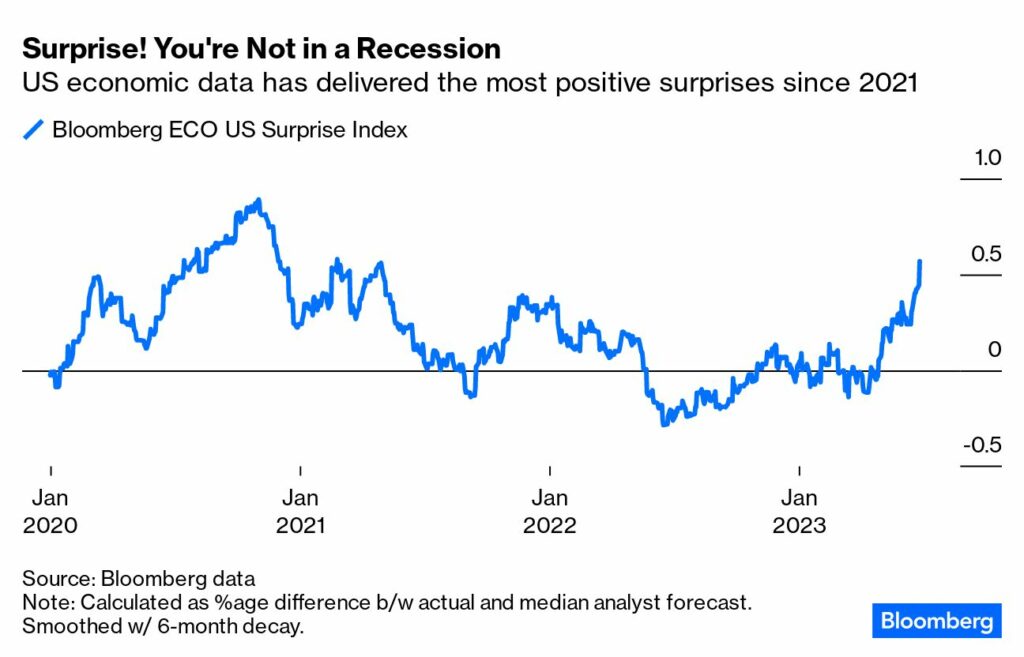
Recent economic data has showed that growth is holding up: [13]
– New home sales soared 12.2% (vs forecast -1.2%).
– Consumer confidence measured by the Conference Board rose to 109.7, the highest since early 2022 (vs forecast 104).
– The final revision to US 1st quarter GDP showed the economy grew at a 2% annualized pace, well above the 1.3% previously reported[14]
– Jobs continue to be added at a pace well above its pre-pandemic average.[15]
– Banks passed the annual Fed stress test that measured resilience under a severe recessionary condition.[16]
Although there are signs of a slow-moving credit crunch, as Dr. Ed Yardeni, a former economist with the Federal Reserve notes, the permabears have to postpone the imminent recession again – the “rolling recession” has turned into a “rolling expansion.”[17] [18]
Why has the economy held up so well? Part of the answer might arrive from the fact that the government keeps spending. Intuitively, the federal deficit as a percentage of GDP typically moves in tandem with the unemployment rate. When unemployment is high, tax receipts fall and government spending increases; when unemployment is low, we might expect spending to recede.
Perhaps unexpectedly, unemployment and federal deficit spending has diverged. US deficit spending on the back of public investments in infrastructure, the Chips Act, etc., is high relative to the strength of the economy.[19] The current deficit is comparable to levels of spending seen in 2011 when unemployment was around 8%.[20] Even as monetary policy has tightened, fiscal policy has stepped in to provide the economy with broad support.
What’s Next?
The S&P’s 15.9% increase in 2023 has surprised many analysts. The markets embraced leading tech stocks, inflation seemingly peaked, and any major banking and debt ceiling crisis were avoided.[21] We will continue to monitor upcoming earnings, and inflation-related data, and any credit or liquidity issues stemming from higher interest rates.[22] Embracing a balanced perspective with a strong emphasis on diversification prepares your portfolio for the inherent and unpredictable fluctuations of the markets.
As always, we are happy to help you with any questions about the markets, economy, and your customized investment portfolio. Please feel free to reach out to with any questions or to schedule a simple call about your personal goals and objectives – especially if there have been any recent life changes. We hope you’re enjoying a relaxing and fruitful summer with family and friends.
Your Friends at JSF
The information expressed herein are those of JSF Financial, LLC, it does not necessarily reflect the views of NewEdge Securities, Inc. Neither JSF Financial LLC nor NewEdge Securities, Inc. gives tax or legal advice. All opinions are subject to change without notice. Neither the information provided, nor any opinion expressed constitutes a solicitation or recommendation for the purchase, sale or holding of any security. Investing involves risk, including possible loss of principal. Indexes are unmanaged and cannot be invested in directly.
Historical data shown represents past performance and does not guarantee comparable future results. The information and statistical data contained herein were obtained from sources believed to be reliable but in no way are guaranteed by JSF Financial, LLC or NewEdge Securities, Inc. as to accuracy or completeness. The information provided is not intended to be a complete analysis of every material fact respecting any strategy. The examples presented do not take into consideration commissions, tax implications, or other transactions costs, which may significantly affect the economic consequences of a given strategy. Diversification does not ensure a profit or guarantee against loss. Carefully consider the investment objectives, risks, charges and expenses of the trades referenced in this material before investing.
Asset Allocation and Diversification do not guarantee a profit or protect against a loss.
The Bloomberg Barclays U.S. Aggregate Bond Index measures the investment-grade U.S. dollar-denominated, fixed-rate taxable bond market and includes Treasury securities, government-related and corporate securities, mortgage-backed securities, asset-backed securities and commercial mortgage-backed securities.
The S&P 500 Index is an unmanaged, market value-weighted index of 500 stocks generally representative of the broad stock market.
The Nasdaq Composite is a market-capitalization-weighted index consisting of all Nasdaq Stock Exchange listed stocks that are not derivatives, preferred shares, funds, exchange-traded funds or debenture securities.
Treasury Bond- is a U.S. government debt security with a fixed interest rate and maturity between two and 10 years.
Gross domestic product (GDP) is a monetary measure of the market value of all the final goods and services produced in a specific time period. GDP is the most commonly used measure of economic activity.
By clicking on these links, you will leave our server, as they are located on another server. We have not independently verified the information available through this link. The link is provided to you as a matter of interest. Please click on the links below to leave and proceed to the selected site.
[1] Stock market today: Live updates (cnbc.com), 6.30.23
[2] https://www.wsj.com/articles/markets-monster-2023-rally-defied-all-expectations-705bc313
[3] Apple’s Market Cap Reaches $3 Trillion (wsj.com)
[4] A Majority of S&P 500 Stocks Are up This Year as Market Breadth Improves (wsj.com)
[5] https://www.wsj.com/articles/treasury-yields-resume-climb-as-investors-bet-on-growth-5d157f69
[6] US bond yields rise as ‘scorcher’ data points to strong economy | Financial Times (ft.com)
[7] Analysis: US bond investors eked out positive returns, see better second half year | Reuters
[8] https://news.yahoo.com/federal-paused-interest-rate-hikes-180025538.html
[9] Fed Holds Rates Steady but Expects More Increases – WSJ
[10] PCE inflation May 2023: Key Fed measure shows prices rose just 0.3% in May (cnbc.com)
[11] PCE inflation May 2023: Key Fed measure shows prices rose just 0.3% in May (cnbc.com)
[12] Markets’ Monster 2023 Rally Defied All Expectations – WSJ
[13]Recession 2023 Might Be Canceled, But Economists Won’t Admit It – Bloomberg )
[14] US bond yields rise as ‘scorcher’ data points to strong economy | Financial Times (ft.com)
[15] https://www.wsj.com/articles/markets-monster-2023-rally-defied-all-expectations-705bc313
[16] Fed stress test 2023: Biggest banks weathered severe recession (cnbc.com)
[17] The Slow-Moving Credit Crunch Is Still Unfolding – Bloomberg
[18] It Was a Week for Feeling Good About the US Economy – Bloomberg
[19] It Was a Week for Feeling Good About the US Economy – Bloomberg
[20] It Was a Week for Feeling Good About the US Economy – Bloomberg
[21] Stock market today: Live updates (cnbc.com) 6.30.23
[22] Six questions facing US stock investors as 2023’s second half nears | Reuters
Read more
9 June
AI Fueled Markets Defy Debt Ceiling Drama
Quick Take: Amidst the final stretch of debt ceiling negotiations to avoid a US default, equities and bonds remained resilient, with AI-related names leading the charge.
Mega tech companies continued a year-to-date market dominance as the tech-heavy Nasdaq rose 5.8%, outperforming the S&P 500 equity index, which increased 0.3%.[1] Five stocks — Microsoft, Alphabet Inc. (Google parent company), Nvidia, Apple, and Meta Platforms — are responsible for the S&P 500’s entire 9% year-to-date return.[2]
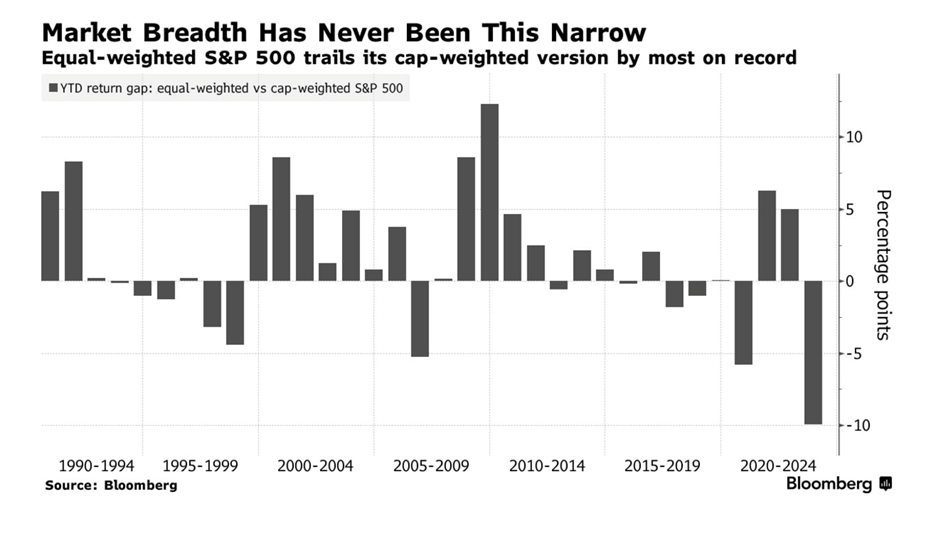
Source:https://www.bloomberg.com/news/articles/2023-05-26/ai-oligarchy-becoming-the-stock-market-s-answer-to-everything?
Never have indexes like the S&P 500 and Nasdaq 100, which are the targets of trillions of dollars in passive investments, relied heavily on so few stocks for performance.[3]
The excitement surrounding the productivity-boosting potential for “generative artificial intelligence” (the technology used to create chatbot ChatGPT) has fueled these stock market gains. Research findings indicate that 25% to 50% of year-to-date S&P 500 gains could be due to the buzz around AI.[4]
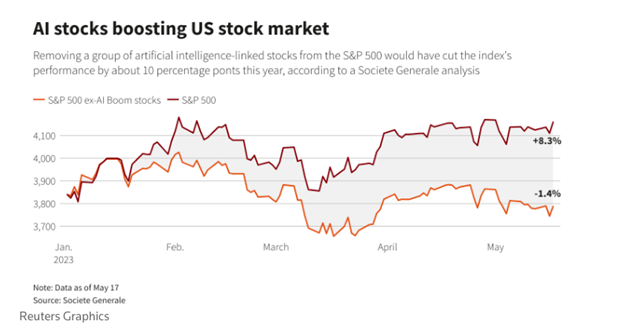
Source: https://www.reuters.com/markets/us/wall-st-week-ahead-artificial-intelligence-gives-real-boost-us-stock-market-2023-05-19/
Optimism is reflected in soaring share prices for companies like Nvidia, whose chips play a vital role in development. Nvidia’s shares have tripled in less than eight months, with the market capitalization briefly surpassing $1 trillion in May.[5] Only four other US companies currently have a valuation of more than $1 trillion.[6]
The attention on AI centers around its potential impact. According to Goldman Sachs, generative AI could expand profit margins for S&P 500 companies by 30% or more over the next decade.[7]
Down to the Wire
Riding the wave of AI euphoria, markets traded near 2023 highs even as concerns lingered over ongoing debt ceiling negotiations.[8] Despite no shortage of political theater, markets seemed to believe that the US would ultimately avoid a default Treasury Secretary Yellen warned could have happened on June 5th.[9]
The last-minute deal passed by Congress and signed by President Biden suspends the $31.4 trillion debt ceiling through January 1, 2025, until after the 2024 presidential election.[10] Student loan repayments, which have been on pause since the pandemic, must restart, and non-defense spending will be capped for the next two years, while clean energy measures passed in the Inflation Reduction Act will remain.[11]
Spring Bonds Rally
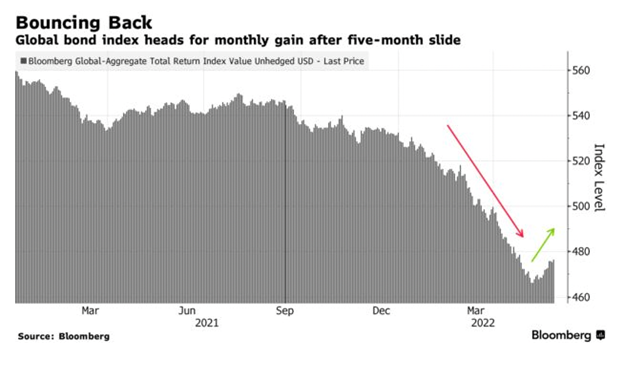
Source: https://www.bloomberg.com/news/articles/2022-05-30/bonds-rally-everywhere-in-may-with-bulls-saying-selloff-is-over
Despite the debt ceiling overhang, bonds enjoyed a spring rally, as US Treasuries logged their best month since November and global corporate debt advanced the most since July.[12] Investors believe central bank rate hikes are mostly priced in, and yields remain at attractive levels to buy bonds. Asset managers like JPMorgan, Morgan Stanley, and PIMCO have gone on record supporting the view that the global debt selloff appears to be over.[13]
That being said, after the debt ceiling deal, we expect the Treasury to unleash a flood of Treasury bill issuance –debt with maturities under a year — to replenish coffers, which could cheapen Treasury bill prices and potentially draw liquidity from the market.[14]
Fed Guidance
While the debt ceiling debate has reached a near-term resolution, the economy still has an inflation problem that the Federal Reserve (“Fed”) has tried to remedy through increasing interest rates. In early May, policymakers increased the benchmark federal funds rate for the 10th consecutive time to a range of 5.00%-5.25%.[15]
Stronger than expected economic indicators have emerged since the May Federal Open Market Committee (“FOMC”) meeting. The unemployment rate reached a multi-decade low of 3.4% in April, while the Fed’s preferred gauge for inflation stands at 4.4% — still more than double its target.[16] Additionally, job vacancies unexpectedly surged in April to the highest level in three months.[17] These factors give the Fed more reason to consider hiking interest rates soon.
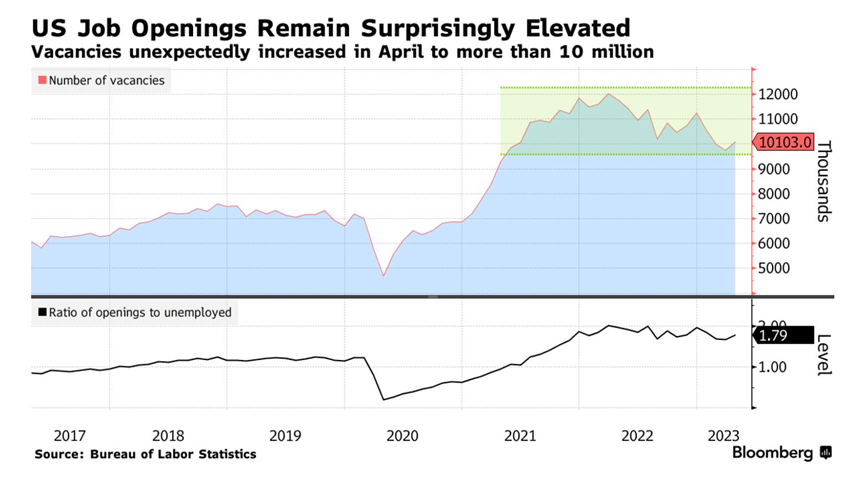
Source: https://www.bloomberg.com/news/articles/2023-05-31/us-job-openings-surge-to-10-1-million-exceeding-all-estimates?cmpid=BBD053123_BIZ&utm_medium=email&utm_source=newsletter&utm_term=230531&utm_campaign=bloombergdaily
However, minutes from the FOMC meeting showed that policymakers generally agreed that the need for further rate hikes “had become less certain”.[18] Fed policymakers have recently signaled the likelihood of taking a break from hiking rates during the next June 13-14 meeting.[19] [20] However, a decision to maintain the current policy rate in favor of a wait-and-see approach doesn’t mean we’re at the peak rate for this cycle. Rather, many believe we are nearing the finish line for future rate hikes.
Looking Ahead
Although strong economic data seems to have lessened the risk of a near-term recession, the full effects of central bank tightening have not yet materialized. Moving into the second half of the year, we anticipate continued doses of market volatility. As a result, prioritizing portfolio diversification and following a prudent investment strategy remains critical.
As summer approaches, we’d like to extend our heartfelt congratulations to all graduates and their families. We celebrate your achievements and look forward to seeing what the future holds! Additionally, here’s a special shout out to the dads as we shine a light on you during your upcoming festivities – Happy Father’s Day!
Lastly, a reminder that our office will be closed on Monday, June 19th for the Federal Holiday of Juneteenth. Banks, as well as the stock markets, will be closed that day. JSF will reopen under normal business hours on Tuesday, June 20th.
Wishing everyone a wonderful start to summer festivities and the (un)official start to travel season!
Your Friends at JSF
The information expressed herein are those of JSF Financial, LLC, it does not necessarily reflect the views of NewEdge Securities, Inc. Neither JSF Financial LLC nor NewEdge Securities, Inc. gives tax or legal advice. All opinions are subject to change without notice. Neither the information provided, nor any opinion expressed constitutes a solicitation or recommendation for the purchase, sale or holding of any security. Investing involves risk, including possible loss of principal. Indexes are unmanaged and cannot be invested in directly.
Historical data shown represents past performance and does not guarantee comparable future results. The information and statistical data contained herein were obtained from sources believed to be reliable but in no way are guaranteed by JSF Financial, LLC or NewEdge Securities, Inc. as to accuracy or completeness. The information provided is not intended to be a complete analysis of every material fact respecting any strategy. The examples presented do not take into consideration commissions, tax implications, or other transactions costs, which may significantly affect the economic consequences of a given strategy. Diversification does not ensure a profit or guarantee against loss. Carefully consider the investment objectives, risks, charges and expenses of the trades referenced in this material before investing.
Asset Allocation and Diversification do not guarantee a profit or protect against a loss.
The Bloomberg Barclays U.S. Aggregate Bond Index measures the investment-grade U.S. dollar-denominated, fixed-rate taxable bond market and includes Treasury securities, government-related and corporate securities, mortgage-backed securities, asset-backed securities and commercial mortgage-backed securities.
The S&P 500 Index is an unmanaged, market value-weighted index of 500 stocks generally representative of the broad stock market.
The Nasdaq Composite is a market-capitalization-weighted index consisting of all Nasdaq Stock Exchange listed stocks that are not derivatives, preferred shares, funds, exchange-traded funds or debenture securities.
Treasury Bond- is a U.S. government debt security with a fixed interest rate and maturity between two and 10 years.
Gross domestic product (GDP) is a monetary measure of the market value of all the final goods and services produced in a specific time period. GDP is the most commonly used measure of economic activity.
By clicking on these links, you will leave our server, as they are located on another server. We have not independently verified the information available through this link. The link is provided to you as a matter of interest. Please click on the links below to leave and proceed to the selected site.
[1] Stock Market Today: Dow Down at Close As Traders Await Debt-Ceiling Vote (wsj.com)
[2] Wall Street Week Ahead: Artificial intelligence gives real boost to US stock market | Reuters
[3] AI Is Becoming the Stock Market’s Answer to Everything (yahoo.com)
[4] Wall Street Week Ahead: Artificial intelligence gives real boost to US stock market | Reuters
[5] Nvidia briefly joins $1 trillion valuation club | Reuters
[6] Nvidia briefly joins $1 trillion valuation club | Reuters
[7] Goldman Sachs: AI-driven gains could lead to 30% S&P 500 profit spike (cnbc.com)
[8] S&P 500 Hits 2023 High as Attention Grows on Debt-Ceiling Deal – WSJ
[9] Janet Yellen Sets June 5 Deadline for Debt-Limit Accord – WSJ
[10] Here’s what’s in the debt ceiling package | CNN Politics
[11] Here’s what’s in the debt ceiling package | CNN Politics
[12] Bonds Rally Everywhere in May With Bulls Saying Selloff Is Over – BNN Bloomberg
[13] Bonds Rally Everywhere in May With Bulls Saying Selloff Is Over – BNN Bloomberg
[14] Debt deal may provide only short-term market relief | Reuters
[15] U.S. economy little changed, outlook ‘deteriorated’: Fed survey | Reuters
[16] https://www.reuters.com/markets/us/us-consumer-spending-beats-expectations-april-inflation-picks-up-2023-05-26/
[17] US Job Openings Surge to 10.1 Million, Upping Odds for Fed Hike – Bloomberg
[18] Fed agreed need for more rate hikes after May meeting was ‘less certain’ | Reuters
[19] https://www.wsj.com/articles/fed-official-says-rate-pause-doesnt-signal-end-to-hikes-758041e5
[20] A June skip jumps to the fore following latest Fed comments | Reuters
Read more